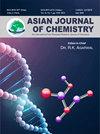In silico Toxicity Assessment and Quantification of Potential Genotoxic Impurity in Olmesartan Medoxomil Drug Substance using GC-MS/MS
Q4 Chemistry
引用次数: 0
Abstract
This study was designed to assess the in silico toxicity of 4-chloromethyl-5-methyl-1,3-dioxol-2-one (4-CMMD) in olmesartan medoxomil (OLM) using sophisticated advanced analytical GC-MS/MS method. The developed GC-MS/MS method is more sensitive as well as selective, for trace level analysis of genotoxic impurity 4-chloromethyl-5-methyl-1,3-dioxol-2-one (4-CMMD) in olmesartan medoxomil (OLM). In silico genotoxicity of 4-CMMD have been confimed by ICH M7 guidelines and tested to be “POSITIVE” in both knowledge and statistical based approaches. The conditions of gas chromatographic separation and mass spectrometry were optimized on stationary phase DB-35MS, helium carrier gas as at a flow rate of 1.5 mL/min. Quantification was performed in multiple reaction monitoring (MRM) mode. The absence of interference at the retention time of 4-CMMD indicates that the newly developed approach is very specific and selective for accurately measuring trace levels of impurities. Additionally, this method provided linear results which were validated by linearity solutions, with concentrations ranging from 3.74 to 45.12 ppm and an observed coefficient of regression of 0.9981. Sensitivity results shows this method is more sensitive detection limit (DL) achieved at 1.23 ppm and quantification limit (QL) achieved at 3.74 ppm. The developed method is precise and accurate according to the precision results, which show RSD values < 10% and recovery > 90%, both of which are within acceptable standards. The solution stability of the samples was assessed at both room temperature and refrigerated settings, and it was found to be stable for a period of 48 h. As a result, this method has been employed for the intented purpose of quantifying 4-CMMD at the trace levels in testing laboratories, pharmaceutical analytical laboratories, and quality control laboratories.利用 GC-MS/MS 对奥美沙坦酯药物中潜在的基因毒性杂质进行硅学毒性评估和定量
本研究旨在采用先进的 GC-MS/MS 分析方法,对奥美沙坦酯(OLM)中的 4-氯甲基-5-甲基-1,3-二氧戊环-2-酮(4-CMMD)的化学毒性进行评估。所开发的 GC-MS/MS 方法具有更高的灵敏度和选择性,可用于痕量分析奥美沙坦酯(OLM)中的遗传毒性杂质 4-氯甲基-5-甲基-1,3-二氧戊环-2-酮(4-CMMD)。根据 ICH M7 准则对 4-CMMD 的遗传毒性进行了硅学分析,并通过知识和统计方法测试其为 "阳性"。优化了气相色谱分离和质谱分析的条件,固定相为 DB-35MS,载气为氦气,流速为 1.5 mL/min。定量采用多反应监测(MRM)模式。4-CMMD 的保留时间没有干扰,这表明新开发的方法具有很高的特异性和选择性,可准确测量痕量杂质。此外,该方法的线性结果经线性溶液验证,浓度范围为 3.74 至 45.12 ppm,回归系数为 0.9981。灵敏度结果表明,该方法的检测限(DL)为 1.23 ppm,定量限(QL)为 3.74 ppm,灵敏度较高。精密度结果表明,所开发的方法精密准确,RSD 值小于 10%,回收率大于 90%,均在可接受的标准范围内。在室温和冷藏条件下对样品溶液的稳定性进行了评估,结果表明样品溶液在 48 小时内保持稳定。因此,该方法可用于检测实验室、药物分析实验室和质量控制实验室对 4-CMMD 进行痕量定量。
本文章由计算机程序翻译,如有差异,请以英文原文为准。
求助全文
约1分钟内获得全文
求助全文
来源期刊

Asian Journal of Chemistry
化学-化学综合
CiteScore
0.80
自引率
0.00%
发文量
229
审稿时长
4 months
期刊介绍:
Information not localized
 求助内容:
求助内容: 应助结果提醒方式:
应助结果提醒方式:


